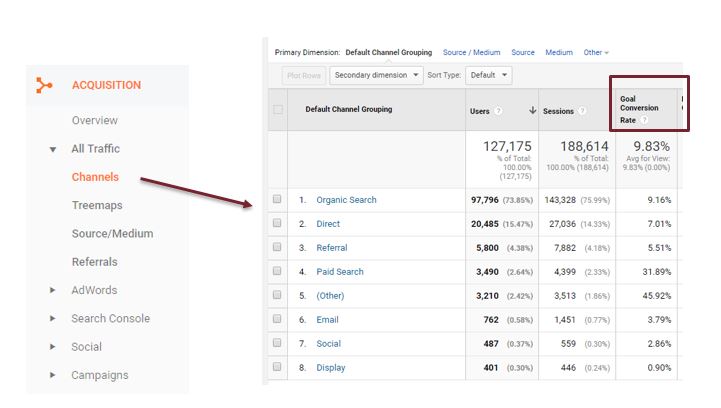You’ve worked hard to develop your hospital’s website into a strategic tool that supports your organization’s goals. But do you know how well your site is actually helping you to meet them? Setting up baseline and macro goals in Google Analytics (GA) can take your measurement to the next level and prove your website’s value. Here’s how.
Using Google Analytics Goals to Avoid the Measurement Rabbit Hole
One of the beautiful things about digital marketing is that there’s so much data available to help assess the success (or failure) of our efforts. One of the downfalls of digital marketing is that there’s so much data available. So much data that deciding which metrics are the best ones to measure can often feel like going down the proverbial rabbit hole.
So how can you focus on the metrics that will give you the best understanding of your site’s performance? Setting macro goals in GA is one incredibly effective way. But first you’ll want to ensure you’re measuring baseline metrics.
Step One: Baseline Metrics
Measuring baseline metrics is the foundation of any analytics effort and includes things like:
- Sessions
- Mobile vs. desktop traffic
- Pageviews
- Top landing pages
- Engagement stats, such as time on site, pages/visit, and bounce rates
- Downloads
- And more
Especially when trended over time and compared year-over-year, this data provides an overall understanding of your site’s health.
It also helps to uncover potential issues so that they can be addressed and, if needed, quickly corrected. Through baseline metric measurement that’s captured and reported during Geonetric’s Stat calls, we’ve consulted with clients on many issues we’ve uncovered – both simple and complex. This measurement has helped remedy everything from high bounce rates on service pages (created campaign landing pages), to skewed data (fixed extra tracking code that had been placed on a site), to user search issues (updating task menu based on repeatedly searched for terms).
So baseline data that’s trended over time and routinely reviewed is a fundamental analytics best practice, and why we include Stat in our client support packages as well as our Dashboard tool for high-level data monitoring.
But once you have baseline data in place, what’s the next step?
Step Two: Micro and Macro Goal Setting
Here’s where things get really fun! Using GA to set and track both micro and macro goals helps you to understand two key things:
- User intent and engagement through specific action tracking. (Micro)
- Overall conversion rates by channel across your site or by page/section. (Macro)
GA allows you to set tracking for what it refers to as “events.” Event tracking lets you track specific actions on your site (micro goals), such as outbound link clicks, click-to-call phone numbers, button clicks, video views, downloads, and other interactions with content that help you understand user intent and engagement. This data helps marketers understand what elements of a page are leading users toward key actions, and where you might need to alter page layout, content, etc. to increase the chances of conversion.
On the other hand, setting up overall site goals (macro) in GA allows you to measure true conversions – things like physician appointment requests, class and event registrations, or donations – where actual dollars are being driven in the door. These are considered macro goals because no matter where a user is on your site, if his or her visit results in one of these activities, you’ve clearly converted them into either a new or returning patient or customer. Now, this conversion may or may not ultimately result in actual dollars in the door (a patient can cancel an appointment, for example), but the user has converted on-site, and you have critical information to pass through to your CRM system (or otherwise) to allow you to measure ROI.
Here’s an example that highlights the difference between the goal types:
Let’s say I’m running a campaign for my Orthopedics second opinion program, and have created a landing page to drive traffic from PPC, display ads, social media, and an eNewsletter.
My landing page includes:
- A form to request an appointment with a physician
- A video about our second opinion program
- A PDF of a second opinion program fact sheet
- A click-to-call phone number to call for more information
To understand how my landing page is performing from a user engagement perspective, I set up event tracking in GA to measure:
- Number of clicks-to-call on the “for more information” phone number
- How many people watch my video 25, 50, 75, and 100 percent of the way through
- The number of people who begin to fill out my form but abandon it prior to submission
- Number of second opinion fact sheet PDF downloads
All of this information, combined with other GA data, helps me understand how well my landing page is doing in engaging visitors. If there aren’t many PDF downloads, I might consider removing that from the page altogether; if the majority of video viewers are watching the video 75% of the way through, that’s a good indication the video is a positive addition to the page; if the number of clicks-to-call for more information is high relative to pageviews, I can assume its placement on the page is good; if a high percentage of people are abandoning my form before submission, I should consider shortening it or altering the information I’m asking for.
While all of this data gives me great insight into potential changes to my landing page to better drive conversion, none of it helps me understand what traffic channels are creating the most on-site conversions or exactly how many of these visits are resulting in appointments. This is where our macro goals come in, and why they’re so critical.
With a GA Goal set up to track physician appointment request form submissions, I can use that goal to see how traffic from my various campaign channels is converting. Here’s what that looks like in GA:

In this sample screen shot, you can see that the channel “other” (often display ads fall here) is driving the highest conversions, followed by paid search, organic, direct, referral, email and social. Based on this data analyzed over a significant enough time period, I may decide to adjust my spend toward a heavier allocation in display ads if they continue to drive the highest conversions, and reduce spend in lower converting channels. (Hint: Use UTM codes to go even one step deeper in getting insight into specific medium conversion rates.)
With GA Goals set up, you can view conversion rate for your site as a whole, or drill down to the page or section level. You can view conversions as a total across all goals you have set up, or see conversion rates by individual goals.
Having this macro data helps you to answer the larger question of overall site or campaign success at a true conversion level. And that is the data your executives and other key stakeholders will be most interested in. Micro data is valuable and critical data for marketers to glean to help refine our efforts, but as you can see, not necessarily material for your next executive meeting … unless, of course, you have executives who really love to dig into that level of detail!
How Do I Get Started?
If you have time, there are many helpful articles and tutorials online to help you learn more about GA event tracking and goals, including Google’s documentation on Events and Goals.
Also, check out our white paper 10 Google Analytics Tools for Healthcare Marketers. If you want or need help, we’ve set up event and goal tracking for many clients, and we’d love to do this for you, too. We’re excited for you to take your measurement to the next level!

